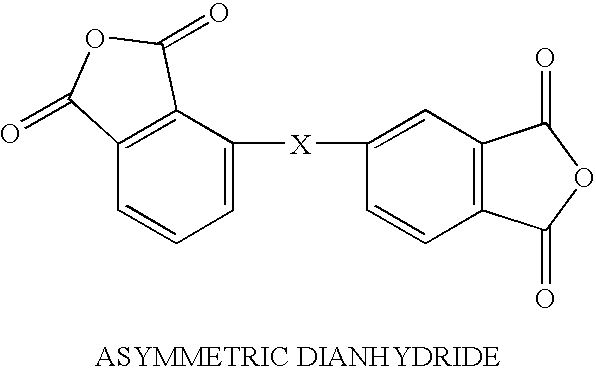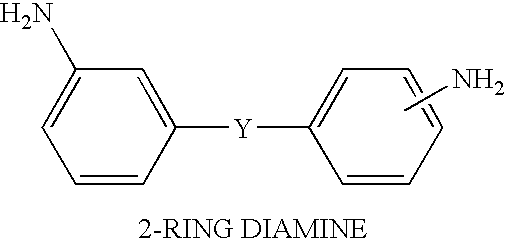Solvent free low-melt viscosity imide oligomers and thermosetting polyimide composites
a technology of imide oligomers and thermosetting polyimides, which is applied in the direction of organic chemistry, transportation and packaging, synthetic resin layered products, etc., can solve the problems of difficult removal of nmp or any other organic solvent from the oligomers, delamination in the final composite, and cost additional time and labor which is not very cost-effective, and achieves low-melt viscosity
- Summary
- Abstract
- Description
- Claims
- Application Information
AI Technical Summary
Benefits of technology
Problems solved by technology
Method used
Image
Examples
example i
[0018]4-phenylethynylphthalic anhydride (6.206 g, 25 mmol) and 2,3,3′,4′-diphenyl tetracarboxylic dianhydride (3.678 g, 12.5 mmol) were mixed with 3,4′-diaminobenzophenone (5.5 g, 25 mmol) as a solid mixture with either ball mill or an efficient mechanical stirrer until it became a homogeneous powder mixture. The solid powder mixture was heated to 232° C. (450° F.) from room temperature in 30 minutes and then held at 450° F. for 1 hour to melt the monomers initially and then reacted with all the monomers to form an imide oligomer. The resulting oligomer resin was then grounded into a solid powder with a melt viscosity of 5–10 poises as measured by the Brookfield viscometer. The low-melt viscosity resin was processed by resin transfer molding (RTM) or resin film infusion (RFI) and cured at 700° F. (371° C.) for 2 hours to yield a thermosetting polyimide with a Tg of 350° C.
example ii
[0019]4-phenylethynylphthalic anhydride (0.24 g, 30 mmol) and 2,3,3′,4′-diphenyl tetracarboxylic dianhydride (8.816 g, 30 mmol) were mixed with 3,3′-diaminodiphenylmethane (4.01 g, 45 mmol) as a solid mixture with either ball mill or an efficient mechanical stirrer until it became a homogeneous powder mixture. The solid powder mixture was heated to 232° C. (450° F.) from room temperature in 30 minutes and then held at 450° F. for 1 hour to melt the monomers initially and then reacted with all the monomers to form an imide oligomer. The resulting oligomer resin was then grounded into a solid powder with a melt viscosity of 10–20 poises as measured by the Brookfield viscometer. The low-melt viscosity resin was processed by resin transfer molding (RTM) or resin film infusion (RFI) with a carbon fiber preform and cured at 700° F. (371° C.) for 2 hours with the carbon fiber and then further post cured at 650–700° F. for 8–16 hours to yield a thermosetting composite with a Tg of 310° C.
example iii
[0020]4-phenylethynylphthalic anhydride (7.44 g, 30 mmol) and 4,4′-(hexafluoroisopropylident)diphthalic anhydride (6.66 g, 15 mmol) were mixed with 1,3-bis(4-aminophenoxy)benzene (30 mmol) as a solid mixture with either ball mill or an efficient mechanical stirrer until it became a homogeneous powder mixture. The solid powder mixture was heated to 232° C. (450° F.) from room temperature in 30 minutes and then held at 450° F. for 1 hour to melt the monomers initially and then reacted with all the monomers to form an imide oligomer. The resulting oligomer resin was then grounded into a solid powder with a melt viscosity of 10–20 poises as measured by the Brookfield viscometer. The low-melt viscosity resin was processed by resin transfer molding (RTM) and resin film infusion (RFI) with a carbon fiber preform and cured at 700° F. (371° C.) for 2 hours with the carbon fiber and then further post curred at 650–700° F. for 8–16 hours to yield a thermosetting polyimide composite with a Tg o...
PUM
| Property | Measurement | Unit |
|---|---|---|
| temperature | aaaaa | aaaaa |
| glass-transition temperature | aaaaa | aaaaa |
| glass-transition temperature | aaaaa | aaaaa |
Abstract
Description
Claims
Application Information
 Login to View More
Login to View More - R&D
- Intellectual Property
- Life Sciences
- Materials
- Tech Scout
- Unparalleled Data Quality
- Higher Quality Content
- 60% Fewer Hallucinations
Browse by: Latest US Patents, China's latest patents, Technical Efficacy Thesaurus, Application Domain, Technology Topic, Popular Technical Reports.
© 2025 PatSnap. All rights reserved.Legal|Privacy policy|Modern Slavery Act Transparency Statement|Sitemap|About US| Contact US: help@patsnap.com



